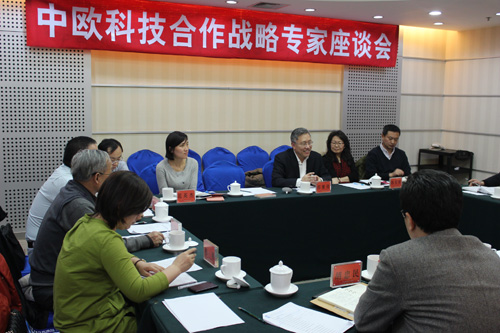
On March 6, 2014, China Science and Technology Exchange Center (CSTEC) held in Beijing the China-EU S&T Cooperation Strategy Symposium, attended by experts from Chinese Academy of Science and Technology for Development (CASTED), Chinese Academy of Sciences (CAS), Chinese Academy of Agricultural Sciences (CAAS), Chinese Academy of Medical Sciences (CAMS), National Natural Science Foundation of China (NSFC), Beijing Municipal Science & Technology Commission, Science & Technology Commission of Shanghai Municipality, China Association for International Science and Technology Cooperation (CAISTC), China Aerospace Science & Technology Corporation (CASC) and ZTE Corporation.
In the context of adjusting Europe 2020 Strategy and acting upon Horizon 2020, the Symposium is aimed at dealing with strategic issues of China-EU S&T cooperation, as well as sharing experience and practices in collaborating with the EU in the sphere of S&T.
The experts commented on the international ecosystem for China’s S&T cooperation, discussed advantages and problems in China-EU S&T cooperation, and exchanged views on the achievement and expressed their confusion about bilateral cooperation on aerospace, agriculture and communications. It was agreed that China-EU S&T cooperation, among China’s S&T cooperation relationships with other countries over the years, has been the most important one featuring solid foundation and fruitful results. At present, the two sides should push forward pragmatic S&T cooperation by providing more funding, launching more flagship projects and facilitating industrialization. In addition, experts shared views on the policy change of China participating in Horizon 2020. They believed it unwise for both that Horizon 2020 no longer provided financial support to Chinese participants and shut the door for Chinese researchers.
Dr. Xing Jijun, Deputy Director General of CSTEC, pointed out that Chinese research institutes face difficulties and barriers despite its initiative and capability for international high-level research projects. The transformation from general participation to voluntary participation in targeted areas indicated that Chinese research is becoming more open to the outside world. In the future, the two sides should strengthen equal cooperation in areas of mutual interest based on common goals. In governmental and non-governmental level, China-EU S&T cooperation required strategic thinking and policy guidance as well as long-term pro-cooperation mechanism. What’s more, a dynamic environment should be established through various joint projects and promotional initiatives, so as to underpin sustainable China-EU S&T cooperation.

